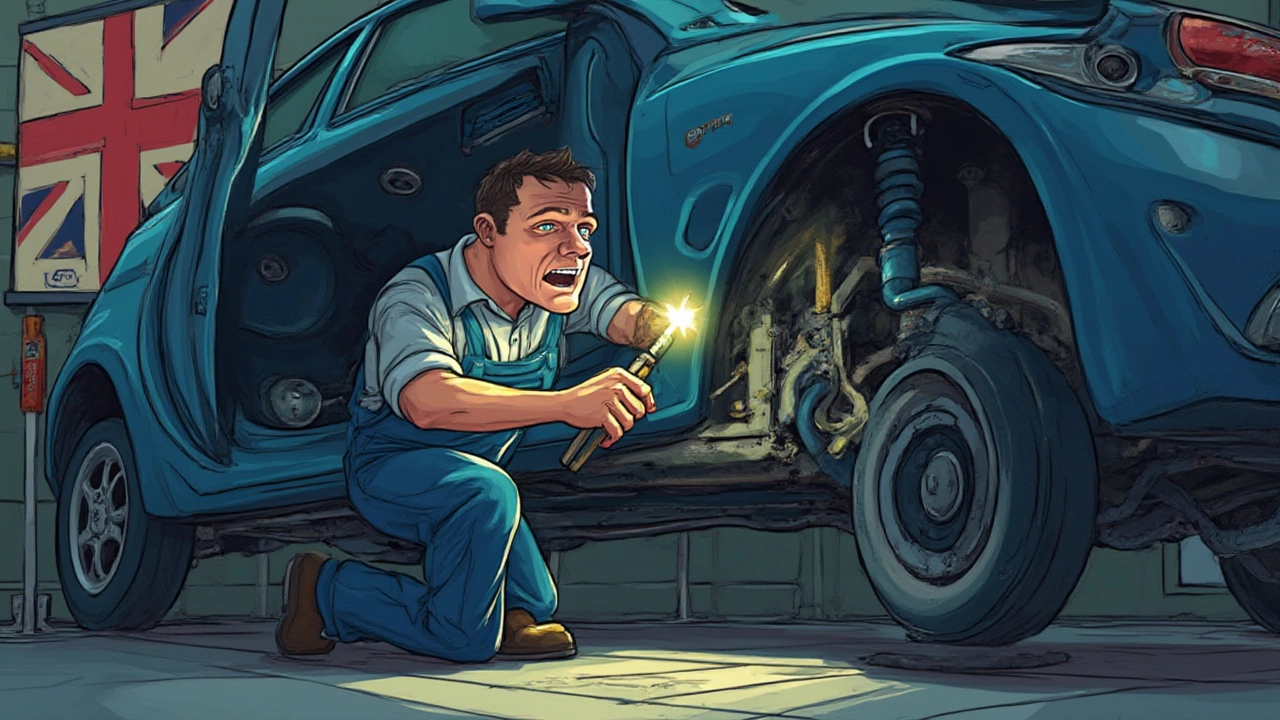Ever wondered why your once smooth ride suddenly feels like you’re bouncing down an old, pothole-ridden road? Car suspension problems sneak up on you. Most people don’t notice a thing until every bump sends shudders up their spine, or that annoying clunk around corners refuses to go away. These issues aren't just annoying—they can mess with your car’s safety, destroy comfort, and cost a small fortune if ignored. Most suspensions aren’t built to last forever, even if you treat your car well. So what causes suspension systems to fail, creak, and downright collapse?
Main Causes of Suspension Damage
Dirt, moisture, relentless potholes—life isn’t kind to your car’s suspension. The average road is loaded with rough patches and obstacles just waiting to chip away at those crucial components. But it’s not just the environment ganging up on your ride. Here’s what really plays havoc with a suspension system:
- Wear and Tear: Shocks and struts are designed to take a beating, but they’re not immortal. Most start showing signs of fatigue anywhere between 50,000 and 100,000 miles. Every time your car soaks up a bump or powers through a turn, it’s using up a little more of its lifespan.
- Potholes, Curbs, and Road Hazards: Smacking a pothole may feel jarring—but your suspension gets the worst of it. Deep craters, speed bumps taken too fast, and even minor curb brushes can bend or dent key parts. Recent studies from the AAA found that Americans spend over $3 billion per year on suspension and alignment repairs due to poor roads alone!
- Corrosion and Rust: Road salt, water, and grime are relentless foes, especially in colder climates. Suspension parts made from metal can develop rust, which weakens springs, control arms, and mounts.
- Broken or Worn Bushings: Rubber bushings separate moving metal parts and soak up vibrations. Over time, rubber breaks down—leading to squeaks, clunks, and unpredictable handling.
- Failing Wheel Bearings and Ball Joints: These parts let wheels spin and pivot. Once they get loose or packed with grime, suspension geometry goes off and noisy, dangerous driving follows.
- Overloading Your Car: Regularly packing your trunk with more than your car’s rated capacity crushes springs and shocks before their time—leading to premature drooping and scraping.
- Neglected Maintenance: If you never check your tires, never inspect bushings, and never correct alignment, you’re asking for trouble. Small issues grow into big headaches the longer you wait.
Mix in factors like aggressive driving, frequent towing, or just ignoring those weird noises, and you’ve got a recipe for disaster. Not every suspension problem announces itself with dramatic shudders—sometimes it’s just a slow, steady sinking feeling as parts quietly wear away.
How to Spot Suspension Trouble Early
Learning to recognize trouble before it empties your wallet is a bit of an art. There’s no magic dashboard light for “suspension is cooked!” but you can stay a step ahead if you pay attention.
- Bouncy Rides: Does the car keep bouncing after going over a speed bump? That’s usually a sign your shocks or struts have lost their edge. Uncontrollable bouncing is a classic warning—especially if you feel unsettled around corners or over uneven ground.
- “Nosedives” and Dips: Watch what happens when you brake hard. If your car’s front end takes a dramatic dive towards the ground, worn-out struts or shocks are likely to blame. Same thing for the rear end squatting under acceleration.
- Clunking, Squeaking, or Rattling Noises: Your car should be quiet and tight over bumps. If it sounds like a clattering toolbox or makes metallic thuds every time you take a turn, something’s loose or broken in the suspension.
- Uneven Tire Wear: Bad suspension makes tires pick up unusual wear patterns—cupping, bald spots, or edges worn more than the rest. If you see this, check the suspension first, not just the alignment.
- Poor Steering Response: Does your car feel slow to respond, or does the steering wheel shake violently at speed? Suspension issues can make steering feel heavy, unresponsive, or just plain scary.
- Car Sitting Low or Leaning: Inspect your car from the side. If one corner sits lower than the rest, a failed spring or busted shock could be to blame.
Want a quick test? Push down hard on one corner of your car, then let go. Your car should bounce up once then settle. If it keeps bouncing, something’s up. Pretty much every mechanic will use this bounce test when checking old shocks or struts.

Which Suspension Parts Fail Most Often?
Not all suspension parts are created equal—some simply give up before others. Here’s a breakdown of the most common points of failure, along with how long you can typically expect them to last, assuming average driving conditions. Check the table for a quick overview:
| Suspension Part | Average Lifespan | Key Failure Signs |
|---|---|---|
| Shock Absorbers | 50,000–100,000 miles | Bouncy ride, nose dives, fluid leaks |
| Struts | 55,000–100,000 miles | Sagging, noise, poor cornering |
| Coil Springs | 100,000+ miles | Uneven ride height, bottoming out |
| Bushings | 40,000–80,000 miles | Squeaks, rattles, loose feeling |
| Ball Joints | 70,000–150,000 miles | Clunking, loose steering |
| Tie Rod Ends | 50,000–100,000 miles | Wandering steering, uneven tire wear |
| Wheel Bearings | 80,000–120,000 miles | Growling, humming noise |
It’s worth mentioning that most modern cars now use MacPherson struts in the front—not just plain shock absorbers. Struts combine a shock and a coil spring. They handle both damping (the “shock” part) and supporting the car’s weight (the “spring” part), so when they go bad, you get a double dose of trouble. Don’t forget about control arms, stabilizer links, and sway bars—while not replaced as often, they love to loosen up as cars age, producing pops and knocks you can’t ignore.
Heavy SUVs and vehicles with aftermarket rims or low-profile tires can wear out suspension bits much faster than your average compact sedan. Low-profile tires look cool, but they transfer more road shock up to the suspension—making failures appear earlier than expected.
Preventing Suspension Problems and Extending Lifespan
Want to keep those trips to the suspension shop few and far between? Here’s how folks keep their car suspension in fighting shape for years:
- Watch Your Driving: Cautious driving is suspension-friendly. Slow down for potholes, rough patches, and those “invisible” speed bumps at night. If you have to drive over rough roads daily, take it slow and avoid hard impacts.
- Keep Everything Clean: After every winter (especially if you live where they salt the roads), rinse your car’s underbody. Getting rid of salt and debris prevents hidden rust on springs and mounting hardware.
- Don’t Overload: Check your owner’s manual for maximum load capacity. It’s easy to forget how much extra weight taxes the suspension—heavy loads cause parts to fatigue sooner.
- Stick to a Maintenance Routine: Regular alignment checks, tire balancing, and spot inspections at every oil change are a smart move. Many suspension fixes start small, and catching loose parts early means cheap repairs.
- Change Tires on Time: Driving on worn-out, uneven, or underinflated tires puts extra work on the suspension. New tires with even tread help soak up road shock and reduce extra bouncing.
- Listen for Noises: Weird sounds mean something’s loose, bent, or broken. Don’t put off repairs—problems won’t get better on their own.
- Keep an Eye Out for Leaks: If you see oil dripping from your shocks or struts, that’s internal fluid. This means they’re not damping properly anymore and are due for replacement.
If you’re a numbers person, research from Monroe (a major shock absorber brand) says that nearly 1 in 5 vehicles on the road are rolling around with at least one bad shock or strut. That means millions are driving around on suspension systems well past their best, risking comfort, control, and safety without even realizing.
And for the DIY folks: Replacing shocks, springs, or bushings isn’t as glamorous as tweaking your engine, but it makes just as much difference in how your car feels on the road. If you’ve got basic tools, some parts (like bushings and sway bar links) aren’t hard to swap out at home. But bigger jobs—like pressed-in ball joints or struts under spring tension—might be best left to the pros for safety’s sake.
Staying curious about how your car handles, being picky about weird noises, and giving your suspension regular attention goes a long way. Your back and your bank account will thank you every time you glide over a pothole without spilling your coffee.

